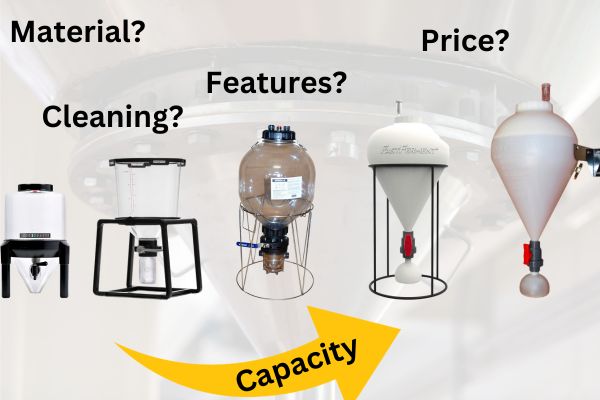In the world of beer, there are countless styles and variations to choose from. Two popular styles that many beer enthusiasts enjoy are bock and ale. Both have rich histories and unique characteristics that set them apart from other types of beer. But what exactly are the differences between these two styles, and which one is right for you? In this post, we’ll take a deep dive into bock and ale, exploring their origins, flavors, brewing processes, and more. By the end, you’ll have a better understanding of these two classic beer styles and be better equipped to choose the one that’s right for you.
Bock vs Ale: The main difference between bock and ale is the type of yeast used in the fermentation process. Bock is a lager beer, which means it uses lager yeast and is fermented at colder temperatures. Ale, on the other hand, uses ale yeast and is fermented at warmer temperatures. Thisdifference in fermentation leads to distinct flavorss and characteristics in the finished beers.
The Origins of Bock
Bock is a strong, dark lager that originated in the German town of Einbeck in the 14th century. The name “bock” is derived from the German word for “goat,” which was often used to symbolize strength and fortitude. Bocks were traditionally brewed in the winter months and enjoyed in the spring, coinciding with the Christian season of Lent. This strong, flavorful beer provided sustenance for monks during their 40-day period of fasting.
Doppelbock: A Bock Variation
Doppelbock, or “double bock,” is a stronger, richer version of the traditional bock. This style was developed by monks in Munich, who needed an even more substantial beer to sustain them during their Lenten fasts. Doppelbocks typically have higher alcohol content and a more robust, malty flavor than their standard bock counterparts.
The Origins of Ale
Ale is one of the oldest styles of beer, dating back thousands of years to ancient civilizations like the Sumerians and Egyptians. The term “ale” originally referred to anybeer made with malted barleyy and brewed without hops. However, as brewing practices evolved and hops became a staple ingredient in beer production, the definition of ale shifted to refer to beers made with top-fermenting yeast strains.
Bock vs Ale: Brewing Process
The brewing process for bock and ale beers is quite similar, with the main difference being the type of yeast used for fermentation. Bock, as a lager, usesbottom-fermenting lager yeast strainss and is fermented at colder temperatures (usually between 45-55°F or 7-13°C). This colder fermentation takes place over a longer period, typically several weeks to a few months, resulting in a cleaner, crisper flavor profile.
On the other hand, ale is brewed with top-fermenting yeast strains and is fermented at warmer temperatures (usually between 60-75°F or 15-24°C). The warmer fermentation leads to a shorter fermentation period, often just a few days to a week. This difference in temperature and fermentation time results in ales having more fruity, estery flavors compared to lagers like bock.
Maillard Reactions: The Key to Bock’s Flavor
One of the key factors that contribute to the unique flavor ofbock beerss is the Maillard reaction. This chemical reaction occurs during the boiling and kilning stages of the brewing process, when amino acids and reducing sugars in the malted barley interact with heat. The Maillard reaction is responsible for the rich, malty, and sometimes toasty or caramel-like flavors found in bock beers.
Bock vs Ale: Flavor Profiles
Bock beers are known for their strong, malty flavors and dark, rich color. They often have notes of caramel, toffee, and toasted bread, with a subtle hop bitterness for balance. Bocks tend to be full-bodied and smooth, with a clean, crisp finish.
Ales, on the other hand, can vary greatly in flavor depending on the specific style. Generally, ales have more fruity and estery flavors due to the warmer fermentation temperatures. Some ales, like IPAs, have a strong hop presence, while others, like stouts, showcase the flavors of roasted malt. Ales can range from light and crisp to dark and full-bodied, making them a versatile beer style.
Bock vs Ale: Alcohol Content
Bocks typically have a higher alcohol content than many other lagers, ranging from 6-7% ABV for a traditional bock and up to 8-12% ABV for doppelbocks. This stronger alcohol content is due to the higher amounts of malt and fermentable sugars used in the brewing process.
Ales can vary greatly in alcohol content, with some session ales coming in at a low 3-4% ABV, while more robust styles like barleywines and imperial stouts can reach 10-12% ABV or higher. The alcohol content of an ale depends on factors like the amount of malt used, the specific yeast strain, and the brewing process.
Bock vs Ale: Food Pairings
Bock beers pair well with rich, hearty dishes and meats like pork, beef, and game. Their strong, malty flavors complement the flavors of roasted and grilled meats, while the beer’s crisp finish helps to cleanse the palate. Bocks also pair well with chocolate and caramel desserts, as their sweet, malty flavors enhance the flavors of the sweets.
Ales are incredibly versatile when it comes to food pairings, as their wide range of flavors and styles can complement a variety of dishes. Lighter ales like pale ales and wheat beers pair well with lighter fare like salads, seafood, and poultry. More robust ales like stouts and porters are a great match for hearty dishes like stews, barbecue, and chocolate desserts.
Conclusion: Bock vs Ale
When comparing bock and ale, it’s essential to remember that they are two diverse styles of beer, each with its unique characteristics and flavor profiles. The main difference between bock and ale lies in the fermentation process, with bock being a lager beer fermented at colder temperatures and ale being fermented at warmer temperatures. This difference in fermentation leads to distinct flavors and characteristics in the finished beers.
To sum up, here are ten key facts about bock and ale:
1. Bock is a lager beer, while ale is fermented with top-fermenting yeast strains.
2. Bock originated in Germany, while ale has ancient roots dating back thousands of years.
3. Bock is known for its strong, malty flavors and dark color.
4. Ale can vary greatly in flavor depending on the specific style.
5. Bock is fermented at colder temperatures, leading to a cleaner, crisper flavor profile.
6. Ale is fermented at warmer temperatures, resulting in more fruity, estery flavors.
7. The Maillard reaction is responsible for the rich, malty flavors found in bock beers.
8. Bock beers typically have a higher alcohol content than many other lagers.
9. Ales can vary greatly in alcohol content, depending on the style and brewing process.
10. Both bock and ale can be excellent choices for food pairings, depending on the specific beer and dish.
Whether you prefer the rich, malty flavors of a bock or the fruity, estery notes of an ale, both styles offer unique and enjoyable drinking experiences. Don’t be afraid to explore the wide world of beer and try new styles – you might just discover a new favorite!
FAQs
What makes a beer a bock?
A beer is considered a bock if it is a strong, malty lager that originated in Germany and typically has an alcohol content of 6-7%.
What is the difference between bock beer and regular beer?
Bock beer is a stronger, maltier beer that is traditionally brewed in the winter and enjoyed in the spring. Regular beer can refer to a variety of styles, but generally has a lower alcohol content and is brewed year-round.
Is Shiner Bock a lager?
Yes, Shiner Bock is a lager.
Is a Bock a lager or ale?
A Bock is a type of lager.
Is Shiner a lager or bock ale?
Shiner is a lager.
What is the difference between bock and dark lager?
Bock is a strong, malty beer traditionally brewed in Germany, while dark lager can refer to any lager that is darker in color and may have a range of flavors and alcohol content.




